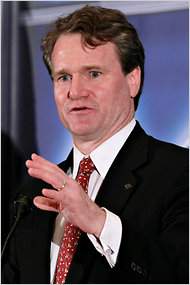 Jeff Kowalsky/Bloomberg NewsBrian T. Moynihan, chief of Bank of America.
Jeff Kowalsky/Bloomberg NewsBrian T. Moynihan, chief of Bank of America.
Bulked up by one-time gains, Bank of America on Thursday reported a fourth-quarter profit after a loss a year ago, but the gain was overshadowed by continuing weakness on Wall Street.
Bank of America earned $2 billion, or 15 cents a share, in the fourth quarter, compared with a loss of $1.2 billion in the same period a year ago.
The earnings met the consensus estimate of analysts polled by Thomson Reuters. The gain, however, included a $2.9 billion profit on the sale of a stake in China Construction Bank as well as a $1.2 billion gain from swapping preferred stock for common shares. Overall quarterly revenue rose 11 percent to $25.1 billion.
For the full year, Bank of America earned $1.45 billion compared with a loss of $2.24 billion in 2010.
One bright spot was Bank of America’s balance sheet, which its chief executive, Brian T. Moynihan, has been trying to strengthen since he took over the beleaguered institution in December 2009. The bank’s Tier 1 capital ratio, a measure of the bank’s underlying strength, rose to 9.86 percent from 8.6 percent a year ago.
Bank of America, which lost its ranking as the biggest bank in the United States to JPMorgan Chase last year, has been submerged by red ink caused by the mortgage meltdown. Its 2008 acquisition of Countrywide Financial, the subprime specialist, is likely to go down in corporate history as one of the most disastrous deals ever, and has saddled the bank with more than $30 billion in losses.
Echoing the trend at Citigroup and JPMorgan Chase, which reported fourth-quarter results earlier, Bank of America’s traditional consumer and corporate lending businesses were much more healthy than capital markets activities like stock and bond trading. The company’s Global Banking and Markets unit, which includes Bank of America Merrill Lynch, saw revenues drop by 31 percent as the unit recorded a net loss of $433 million.
In the middle of a huge restructuring that will eventually claim 30,000 jobs, the number of Bank of America employees dropped by roughly 7,000 to just under 282,000.
The company, based in Charlotee, N.C., which required two government bailout loans totaling $45 billion in the throes of the financial crisis, has seen its stock plummet since then, with its shares at $6.80 before the start of trading Thursday.
Article source: http://dealbook.nytimes.com/2012/01/19/bank-of-america-swings-to-a-profit/?partner=rss&emc=rss